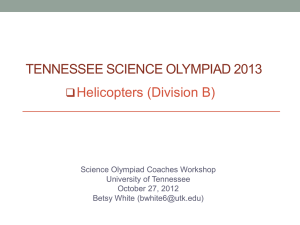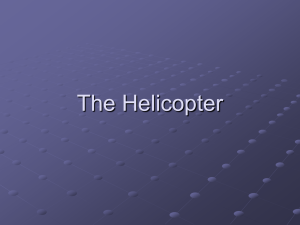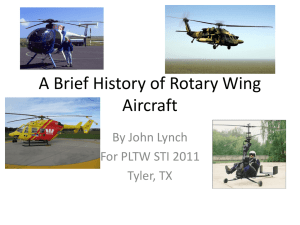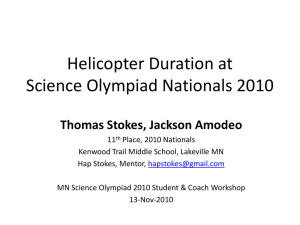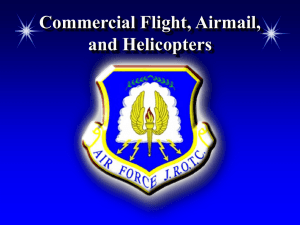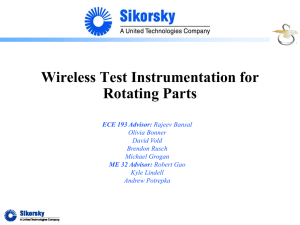(small) - Fly Higher Project
advertisement
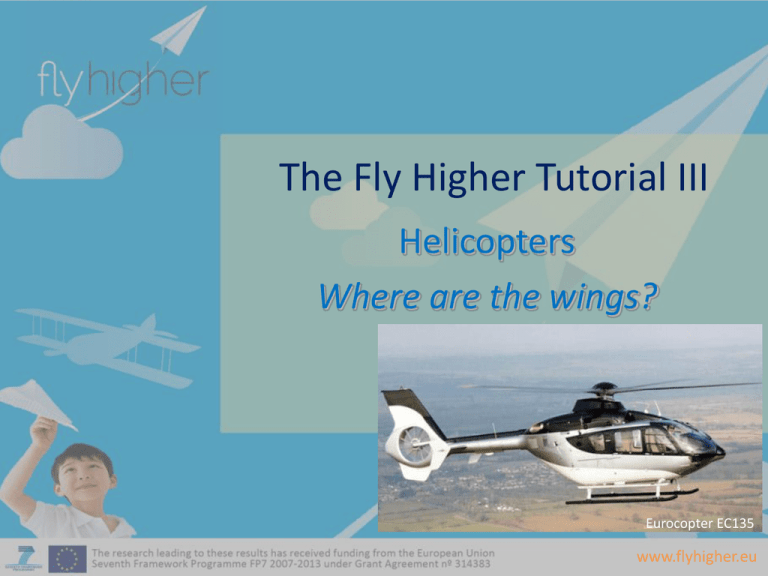
The Fly Higher Tutorial III Helicopters Where are the wings? Eurocopter EC135 www.flyhigher.eu First: Some History Leonardo da Vinci designed the first ‘helicopter style’ aircraft which he called the ‘Helical air screw’. Though drawn with instructions on how it would operate it was never made or tested at the time. Modern day physics suggests this would not fly. You should have heard of Leonardo da Vinci! What else is he most famous for? www.flyhigher.eu Leonardo da Vinci Some History Was not only a pre-eminent scientist and engineer in his time (late 15th Century) but also…. A fantastic artist, best known for painting ‘Mona Lisa and the mural ‘The Last Supper’ And a pioneering student of human anatomy, illustrated by this famous diagram: ‘The Viruvian Man’ www.flyhigher.eu First Working Helicopters Some History In 1906, two French brothers, LouisCharles and Jacques Bréguet, began experimenting with wing shapes for helicopters; in 1907 they successfully demonstrated the potential for rotary-winged flight with Gyroplane No 1. It took 40 years more for man to perfect the design of the helicopter. In 1944, Igor Sikorsky, a Russian born American, flew the first mass produced Helicopter, the Sikorsky R-4. www.flyhigher.eu First Working Helicopters Some History Early take off of a Sikorsky R-4b helicopter. Please watch video 1 take off of a Sikorsky R-4b helicopter Source YouTube HeloSociety Edition Fly Higher Source Youtube HeloSociety www.flyhigher.eu Today´s Helicopters Today’s helicopters come in many different sizes and can fulfil a variety of roles. They also vary in how they operate and work when in flight. Boeing CH-47 “Chinook” Sikorsky CH-124 “Sea King” Robinson R22 In your groups try to think of as many different roles for helicopters as you can, and why they are preferable to aeroplanes in each case you describe. www.flyhigher.eu Parts of a Helicopter As a class or in groups can you work out what are each of these parts of the Helicopter? 8 6 11 7 9 Can you get all 11? On your table you have the 10 diagram and a list of the names of the technical parts to help. 1 4 5 2 3 www.flyhigher.eu Parts of a Helicopter Hopefully you matched the technical names to the diagram as follows: ANSWERS: Pt1 The Cabin 1) Fuselage. Just like on a plane we need a main body to house the people and attach everything else onto. 2) Landing Skids. These replace the wheels on an aeroplane. Can you explain why a helicopter does not need wheels? 3) Cabin doors. Needed to get people in and out of the aircraft. Helicopters don’t fly as high as commercial airplanes so the doors are generally much lighter than the doors on an aeroplane. Again, can you explain why this would be? www.flyhigher.eu Parts of a Helicopter ANSWERS: Pt2 Tail Section 4) Tail boom. This forms part of the overall structure and encases various parts of the tail section. 5) Elevator. This is controlled by the pilot and allows the Helicopter to pitch up and down. 6) Tail fin. Allows the Helicopter to yaw left and right. 7) Tail rotor. This component pushes the helicopter in the opposing way to the main rotor; Otherwise (as a reaction to the rotor) the helicopter would just spin around and around! www.flyhigher.eu Parts of a Helicopter 8) Rotor. Shaped like aeroplane wings, these spin around to generate the required lift for the aircraft. ANSWERS: Pt3 Powerplant & Main Rotor 9) Engine. This powers the helicopter and comes in varying types and sizes. 10) Transmission. This part converts the horizontal turning motion of the engine into a vertical motion which spins the main rotors. 11) Swash Plate. A complex arrangement of connections which tilt the blades at varying angles to allow the helicopter to move in all directions. www.flyhigher.eu Rotor blades: How do we get into the air? As we have seen previously, the Rotor blades spin around and looked to be shaped like wings, but how does this get a helicopter into the air? Above is an end-view drawing and a picture of a rotor blade. As you can see, these show that the blade is shaped like an aerofoil or aeroplane wing. An aerofoil generates lift by the means of a pressure difference, exactly as it does on an aeroplane. www.flyhigher.eu Rotor blades: How do we get into the air? Air Each rotor blade has it’s top surface curved. We get a large amount of air to flow over the blades by spinning them. The air is forced to flow much faster over the rotor blade than under it. This causes a lower pressure on the top than on the bottom. This pressure difference results in a force LIFT, which pulls the helicopter upwards. The helicopter is effectively ‘sucked’ into the air as it takes–off! www.flyhigher.eu Rotor blades, there´s more! How do we get into the air? Now we know how our ‘LIFT’ is generated, getting us into the air, we must now be able to move around. If we don’t move our blades in any direction but simply leave them spinning we would just continue going straight up! www.flyhigher.eu Moving in the Air But we also want to move left or right, and ‘tilt’ in a certain direction. How do we do that? Blades The Hub Swash Plate Metal Rods [that move up and down tilting the hub and blades] This is where a part of the Helicopter called the Swash Plate comes in. This comprises of a series of metal rods which are located where all the blades of the rotor are connected together, the Hub. This Swash Plate tilts the blades by pushing or pulling at certain points, so altering the pitch (angle) of the blades individually as they revolve around in the air. Simple… Huh? www.flyhigher.eu Rotor blades: there´s still more! If we want to move backwards then we tilt our hub and blades up and we shall move up… and BACKWARDS backwards. If we want to do the opposite and move forward, we tilt our hub and blades forward and give ourselves forward motion. If we want to move sideways we would tilt our hub and blades left or right. FORWARDS LEFT OR RIGHT www.flyhigher.eu How a helicopter is controlled Knowing that the rotor blades will tilt to move the helicopter in various directions, how does the pilot control them? COLLECTIVE This is where the Helicopters three main controls come in: CYCLIC • The Cyclic • The Collective PEDALS • Pedals Pilot’s Chair www.flyhigher.eu How a helicopter is controlled: The Cyclic The cyclic is shaped like a oldfashioned hand brake in a car and controls the Swash plate we looked at earlier. With this ‘control stick’ in one hand the pilot controls the tilt angle of the Swash plate and therefore can decide in what direction the Helicopter flies. www.flyhigher.eu How a helicopter is controlled: The Collective This is shaped like a joystick from an old computer and looks a lot like the control stick airplane pilots use. With this ‘Collective’ controller in their left hand the pilot can determine whether the helicopter climbs or descends. www.flyhigher.eu How a helicopter is controlled: The Pedals Lastly there are two pedals where the pilot must place each foot. With these, the pilot can move the tail rotor sideways so turning the aircraft left or right whilst keeping the fuselage level. With a skilled combination of these three controls the pilot can take the Helicopter almost anywhere! www.flyhigher.eu Helicopters You should now know more than enough to follow this film about helicopters. Please watch video 2 Helicopters for beginners Source YouTube CrazyHeliDude Edition Fly Higher Source Youtube CrazyHeliDude Interested? When you get home have a look at “Helicopters for beginners” on YouTube. There is some fascinating stuff there! www.flyhigher.eu Consortium Follow us on www.flyhigher.eu /groups/Fly-Higher-Project-4737756 /flyhigherproject www.flyhigher.eu For further information flyhigher@inovamais.pt www.flyhigher.eu
